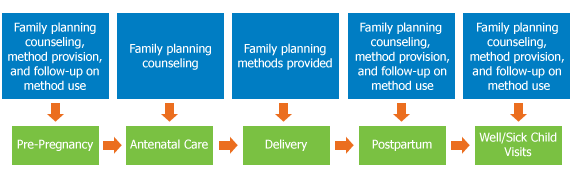
Integrating Family Planning and Maternal and Child Health Services: History Reveals a Winning Combination
(July 2011) PRB’s IDEA project is focusing attention on the integration of family planning into maternal and child health services, a concept that is not new, but for a variety of reasons was embraced in some countries and not in others. In addition to web articles, the PRB policy brief Integrating Family Planning With Maternal and Child Health Services Saves Lives, Time, and Money describes the benefits of integration.
In 1966, the Population Council launched the International Postpartum Program, which soon became one of the largest family planning programs in the world. The program was based on the premise that educating women about family planning during their hospital delivery stay or during a follow-up visit was a highly effective and economical way to help women who had just given birth prevent a subsequent unintended pregnancy. While less than 5 percent of these women express a desire to become pregnant again soon, in developing countries more than one-third are pregnant again within 15 months.1 Initially, family planning was integrated into large maternity hospitals in 14 countries, including the United States, Mexico, Thailand, and Chile.2 A five-year study of 650,000 women attests to the success of the program in increasing contraceptive use and continuation and lowering fertility.3
In a number of countries, these initial integrated programs became essential components of national family planning programs. Not surprisingly, contraceptive use steadily increased, population growth was moderated, and economies grew stronger in these countries. For example, in Thailand, one of Asia’s economic “tigers,” family planning has long been widely integrated with other health services, especially maternal and child health. Seventy percent of married women now use a modern contraceptive, fertility had fallen from 6.7 births per woman in 1967 to less than two by 2000, and women now represent nearly half of nonfarm wage earners. Contrast this with Pakistan, which participated in the early postpartum program but did not make integrated services a part of its national program. Women in Pakistan still have an average of 4 births each, only 22 percent of married women use a modern method, and just 13 percent of nonfarm earners are women. Pakistan’s population growth rate is four times that of Thailand’s, and the government of Pakistan struggles to expand education and basic health and social services.
Integrating Family Planning Into the Continuum of Care for Maternal and Child Health 
The success of the International Postpartum Program led the Population Council to undertake a massive study in 10 countries to determine the needs, costs, and expected impact of universal integrated family planning and maternal and child health services. In 1971, it proposed a global plan with the dual aim of improving maternal and infant care and providing better access to modern contraception.4 This ambitious plan was never brought to fruition, but decades later the value of offering family planning along the continuum from pre-pregnancy and antenatal care through extended postpartum care is being widely discussed as a way to ensure that opportunities to meet the needs of women are not missed.
Providing a woman with multiple opportunities to select a contraceptive method of her choice while receiving other health services for herself or her child is a client-focused approach that is easier and less time consuming for her, and more cost effective for the health system. In reviewing the evidence for integration, the important historical research documenting the broad benefits of an integrated approach should not be overlooked.
Karin Ringheim is senior policy adviser at the Population Reference Bureau.
References
- John A. Ross and William L. Winfrey, “Contraceptive Use, Intention to Use, and Unmet Need During the Extended Postpartum Period,” International Family Planning Perspectives 27, no. 1 (2001): 20-27.
- Gerald Zatuchni and John A. Ross, “The International Postpartum Family Planning Program, Report on the First Year,” Studies in Family Planning 1, no. 22 (1967): 1-23.
- Irving Sivin, “Fertility Decline and Contraceptive Use in the International PostPartum Family Planning Program,” Studies in Family Planning 2, no. 12 (1971): 248-56.
- H. Taylor and B. Berelson, “Comprehensive Family Planning Based on Maternal/Child Health Services: Feasibility for a World Program,” Studies in Family Planning 2, no. 2 (1971): 46.
